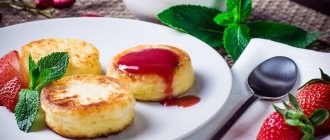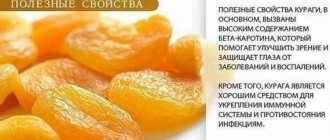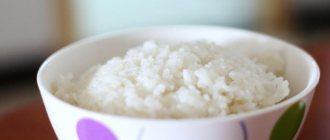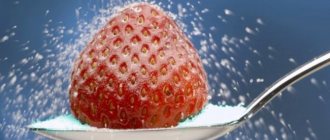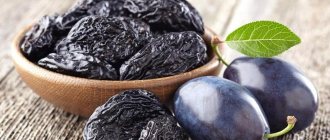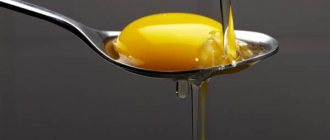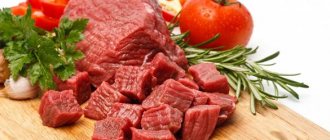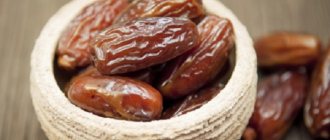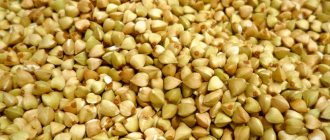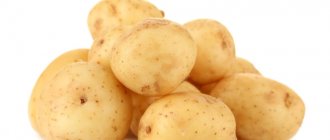If earlier coconut was a curiosity, today you can buy it in any supermarket. It is not only tasty, but also extremely healthy. However, people who watch their figure and try to eat healthy need to know how many calories are in a coconut.
Reference!
The calculator uses average values. The average weight of one Indonesian or Malay coconut in shell is 2.0 kg. The weight of one coconut without shell (pulp and milk) is about 1.5 kg. Coconut milk about 650g.
What do coconuts look like and where do they grow?
Coconut is a round, slightly elongated fruit of the coconut palm. Its length reaches 25 - 30 cm, and its weight is 2.5 kg. People tend to think of coconut as a nut, which is considered a mistake. This is a drupe, the inner part of which is called the endocarp, and the outer part is called the exocarp. The pulp located inside is 12 mm thick and contains liquid containing nutrients, starch and proteins. This water is called edosperm. As soon as the exotic begins to ripen, it is transparent and a little cloudy. In ripe fruit, the water acquires a yellowish tint and is saturated with oils. Mixing with the pulp, the water turns into coconut milk, which has a sweetish taste.
We recommend reading: The benefits and harms of coconut milk for the body
The best soil for coconut palm growth is sandy soil. The wild variety prefers the tropics. Palm trees grow in large numbers along the coastal strip of the Malay Peninsula, Sri Lanka. The habitats of these trees include the Indian coasts and the Philippines. And in Indonesia, the processing and production of coconuts is the most developed, in which it ranks first.
What are coconut meat, coconut milk and coconut juice?
What is a coconut? Is it a nut or maybe a fruit? In fact, the fruits of the coconut palm do not belong to either group; they are drupes and have a rather complex structure: the outer part, covered with hard fibers (coir), is called “exocarp”, the inner part, consisting of a hard shell and the seed itself , – “endocarp”.
Coconut milk is made from coconut meat
If people call coconut a nut, they are making a huge mistake. In fact, it is a drupe or stone fruit such as an apricot, plum or peach.
The contents of a coconut include copra or pulp, a fairly dense, white edible substance, and endosperm, a sweetish liquid that is essentially the juice of the fruit. At first, the endosperm is fluid and transparent, this form is called coconut water. As the nut ripens, the water becomes cloudy and turns into an oily milky emulsion - coconut milk.
Coconut pulp contains a large amount of natural oil, which has high biological and nutritional value. It is isolated from fruits using industrial methods and is widely used in medicine, cosmetology, cooking and many other fields.
Vitamins and minerals in coconut
The benefits and harms of coconut for the human body are being studied by scientists. They claim that the composition of its water resembles the composition of blood. Edosperm contains an amount of useful elements equal to those required by the body. Thanks to its rich composition, drupes can be used in many ways. It contains:
- amino acids;
- antioxidants;
- healthy fiber;
- essential oils.
Exot boasts a rich vitamin composition.
Per 100 g of product there are:
| Vitamin | Amount, mg |
| IN 1 | 0,066 |
| AT 2 | 0,02 |
| AT 3 | 0,3 |
| AT 6 | 0,054 |
| AT 9 | 26 |
| WITH | 3,3 |
| E | 0,24 |
| TO | 0,2 |
| RR | 0,54 |
| Kholin | 12,1 |
The benefits of coconut for the body are enhanced by its rich mineral composition:
| Name | Amount, mg per 100 g |
| Potassium | 356 |
| Calcium | 14 |
| Magnesium | 32 |
| Sodium | 20 |
| Manganese | 1,5 |
| Copper | 0,4 |
| Selenium | 0,022 |
| Phosphorus | 113 |
| Iron | 2,43 |
| Zinc | 1,1 |
Due to the rich mineral content of drupe water, it has beneficial properties for active people and athletes, replacing sports drinks.
Preparing coconut milk
You can easily prepare milk at home using coconut pulp.
The sequence of actions is as follows:
- Break the hard shell.
- Separate the soft layer from the shell.
- Grate the coconut flesh or place it in a blender.
- Fill the container with the pulp with water (hot, but not boiling water) in a ratio of 1:1.5.
- Leave for 2 hours.
- Beat with a blender until smooth.
- Squeeze out the finished mass.
The ready-to-drink drink must be stored in the refrigerator, but no more than four days. A thin film of cream is allowed to appear on the surface. They can be used instead of regular ones.
How many calories are in coconut
Coconut is a unique product. This is high-calorie pulp and water, which contains virtually no calories.
Calorie content and nutritional value (BJU):
| Name | In water, g | In pulp, g |
| Squirrels | 4 | 3,33 |
| Fats | 27 | 33,49 |
| Carbohydrates | 6 | 15,23 |
| Calories | 360 | 16,7 |
The calorie content of a dry tropical delicacy is even higher than that of pulp.
It is 590 kcal per 100 g of product.
Description
Coconut flakes are made from coconut meat. The production of coconut flakes has been launched, but not all countries have switched to fully automated fruit processing. In Indonesia, to this day, coconut pellets are made almost by hand. The pulp from the halved nuts is scooped out using a rotating crusher head (similar to a citrus squeezer), resulting in shavings. In large procurement centers, special presses and drying machines are installed. With their help:
- white coconut pulp is ground;
- crushed fruits are driven under a press, where milk is squeezed out of them;
- the remaining cake is dried and packaged.
The resulting chips are divided into grades depending on the grind size:
- "Сoarse" - coarse coarse shavings. It can be found in markets in countries where coconut grows. Local residents make it themselves.
- “Medium” – medium grind shavings. This variety is produced in factories.
- “Fine” - finely ground shavings, the highest quality grade. This variety is first soaked to preserve its perfect white color, and only then ground. Next it is dried in special ovens. When exposed to high temperatures, grated coconut meat turns into crumbly white granules. Then they are cooled and sifted through a sieve to obtain uniform granules measuring 2-3mm. These shavings are considered optimal in terms of the content of fats, vitamins and microelements. The small granules are crystal white in color and have a subtle pleasant aroma.
In addition to shavings, the dried pulp can be in the form of slabs, chips, or even flour.
Interesting facts about coconut: Benefits of coconut. Coconut water. Use of shells. Types of coconut. How to choose. How to store.
Benefits and harms
Dried dietary fiber from the pulp of an exotic nut has a number of beneficial properties. Vitamins, minerals and microelements contained in the product contribute to:
- Improving the functioning of the digestive system.
- Removing toxins.
- Normalization of the body's metabolic processes.
- Strengthening the immune system.
- Proper development of bone and muscle tissue.
- Healthy hair and nail growth.
Dried granules are recommended for consumption by people with high cholesterol and urological problems. The high manganese content has a positive effect on the construction of connective tissues, which helps the proper physical development of the body. It is worth noting that coconut shavings are less saturated with useful elements than pulp. To obtain the shavings, the pulp is soaked and squeezed, some of the beneficial properties go into the milk.
Coconut flakes are harmful only in two cases:
- allergy to coconuts;
- exceeding the daily norm.
And the daily consumption rate for one adult is 40 grams per day. This amount is sufficient to obtain the required volume of vegetable fats, vitamins and microelements.
Composition and calorie content
The composition of coconut flakes includes:
- vitamins, groups B, E;
- more than 20 amino acids;
- microelements with a high content of magnesium, iron, zinc, phosphorus, potassium, selenium;
- essential oils;
- polyunsaturated fatty acids;
- antioxidants.
It is necessary to understand that the given figures with calorie content and composition are taken as an arithmetic average, because the final content of vitamins, fats and microelements is influenced by too many factors, and they can vary in one direction or another.
The calorie content of dried coconut pulp is 690 kcal per 100 g.
- fats 65 g;
- proteins 13 g;
- carbohydrates 14 g.
The content of proteins, fats and carbohydrates, as well as calorie content, depends on the type of granules. The indicated indicators are characteristic of the fine variety. Even without appropriate markings, it is easy to distinguish it from other varieties - the chips are very small, identical in size. Small granules have less fat because coconut oil is extracted from the pulp first. Low-fat cake has lower nutritional value.
Note! The calorie content of 100 grams of products is compared. Calorie content 100 g
dry coconut shavings are higher than 100 g of coconut pulp, because. 100 g of dry shavings are obtained from 300 g of coconut pulp. The calculation is 300g * 354 kcal (the caloric content of coconut pulp is 354 kcal per 100 g) = 1,062 kcal and subtract the fat content that was lost during soaking. The result is 690 kcal.
Useful properties of coconut
The health benefits and harms of coconut directly depend on the content of vitamins, minerals and nutrients in it. They are the main substances that are required for the proper functioning of internal organs. For athletes, especially weightlifters, the benefits of coconut pulp are valuable. It is rich in proteins, the properties of which help you gain muscle mass faster, and a large amount of calories saturates the body with energy. Coconut is an excellent remedy for people who want to gain the missing weight without harm to their health.
The benefits of coconut pulp are that it:
- strengthens the immune system;
- improves eye health and improves vision;
- normalizes heart function and cardiovascular system functions;
- is a preventative against the harm of malignant neoplasms.
The beneficial properties of coconut pulp do not end there. Like the liquid, it is an anti-inflammatory and antibacterial agent. In general, coconut can be classified as a natural antioxidant.
Milk has diuretic properties. It helps improve the functioning of the kidneys and central nervous system. It is recommended to drink milk to strengthen your teeth and prevent diseases. The liquid contains cytakins, which prevent the harmful formation of cancer cells. Due to the healing properties of milk:
- has a rejuvenating effect;
- is a prophylactic agent for thrombosis;
- improves metabolism and digestion process;
- strengthens the immune system;
- reduces cholesterol and blood sugar;
- normalizes blood pressure;
- prevents the development of atherosclerosis;
- Helps cure sore throat and other colds.
The benefits of young coconut largely lie in its water. It is found only in unripe nuts and is very different from milk in its sweet-sour taste and calorie content. This is an excellent thirst quencher that has beneficial properties that restore water balance in the human body. Among its beneficial properties is the ability to eliminate infections in the bladder. The composition of drupe water can be compared to saline solution.
The benefits of coconut water for delicate skin are great. It helps relieve lethargy, tones the skin, and stops age-related changes. In adolescence, it is used to eliminate acne.
Benefits of coconut for women
The benefits of coconut for a woman’s body are unconditional. Its beneficial substances help strengthen hair. Coconut enriches hair with nutrients and restores it after damage. The beneficial properties of essential oils, milk, water and pulp are used in cosmetology. They are added to masks with anti-aging properties, creams for dry skin, shampoos and rinses. Facial products smooth out and prevent the appearance of age-related wrinkles and tone the skin.
Without any harm, the health benefits of coconut for older women are significant. Its use in food helps improve the functioning of the urinary and reproductive systems, and also delays the onset of menopause.
Benefits of coconut for men
The benefit of coconut for a man’s body is that it is a strong aphrodisiac and strengthens the reproductive system. Exot serves as a prophylactic for prostatitis and diseases of the urinary system. Despite the fact that coconut has health benefits for men, in some cases it can also cause harm. Basically, this occurs with individual intolerance to the product and with obesity.
The use of coconut oil in cosmetology
The body benefits of coconut oil are highly prized in homemade self-care recipes. This useful product has a beneficial effect on the appearance and improves the condition of not only the skin, but also the hair and nail plates.
For facial skin
The product, almost entirely consisting of fatty acids, is ideal for the care of dry and normal skin. The benefits of coconut oil for facial skin are that the fat softens and cleanses the skin, eliminates inflammation and nourishes the epidermis with necessary substances.
The properties of coconut oil for facial skin are fully manifested, even if you simply lubricate your face with the product in its pure form. But fat brings even more benefits in combination with additional ingredients - in masks.
- Using the product and oatmeal steamed in milk, you can make an effective cleansing mask. The product is mixed with soft flakes, a little honey is added and spread over the skin. This useful product quickly removes acne, redness and irritation.
- If you mix honey, sea salt and brown sugar in equal quantities, and then add literally 3 drops of oil to them, you will get a good homemade scrub. It is carefully applied to the face with massage movements, and after 7 minutes, rinsed off and enjoy soft and smooth skin.
The product is often mixed with regular moisturizing and nourishing creams. It enhances the beneficial properties of cosmetic products and helps to better protect the skin from irritation and peeling.
For lips
Based on the product, you can prepare a useful homemade balm that protects your lips from cracking. A teaspoon of fat should be mixed with half a teaspoon of honey and applied to the lips for a quarter of an hour. After this, the fat and honey should be removed with a cloth soaked in warm water.
For eyelashes and eyebrows
The beneficial properties of coconut fat help add volume to eyelashes and eyebrows. It’s enough just to regularly apply undiluted fat before going to bed - lubricate your eyelashes and eyebrows with it, removing excess with a napkin. To prevent oil from getting into your eyes when processing eyelashes, it is best to use a cleanly washed mascara brush.
For hair
The benefits of coconut oil for hair are that the product strengthens the strands, makes them more manageable and facilitates the styling process. The simplest method of application is as follows: the fat is applied to the scalp and strands for half an hour, and then washed off with shampoo.
In addition, you can prepare masks based on the product.
- To strengthen weakened curls, 40 g of coconut fat should be mixed with egg yolk, 10 ml of wine vinegar and half a teaspoon of glycerin.
- To give your hair volume and strength, you can mix 40 g of oil with banana puree and a spoonful of rich sour cream.
All useful masks are kept on the hair for no more than half an hour to avoid harm. The procedure should be repeated at least twice a week, then the effect will be noticeable and permanent.
For nails
The healing properties of coconut oil help restore the strength and shine of the nail plates. Melt a large spoonful of coconut fat over steam, add the same amount of honey and add 4 drops of rosemary oil. After this, the mixture is heated again by steam until it becomes homogeneous and liquid.
The finished product is applied to the nails and rubbed into the cuticle, thin plastic gloves are put on and hands are wrapped in a warm towel. You need to wait a quarter of an hour, then wash off the composition with water.
For stretch marks
This useful product is one of the best remedies for eliminating stretch marks after childbirth or intensive weight loss. About 3 teaspoons of fat should be steamed, add 5 drops of rosemary and rub into the affected areas of the skin for 5 minutes.
For cellulite
The benefits of coconut oil for the body help get rid of unsightly cellulite deposits on the thighs and buttocks. All you need to do is to carefully massage the areas affected by cellulite with oiled hands several times a week.
For Tan
Coconut oil is beneficial for tanning in the sun. Before you go sunbathing, you need to lubricate your entire body with it. The beneficial properties of fat will moisturize, soften and protect the skin from the harm of aggressive sun rays, and also give a fresh tan a pleasant golden hue. It is recommended to lubricate the body both before and after going to the beach, then the effect will be maximum.
For teeth whitening
The benefits of coconut oil in cosmetology are evident in relation to teeth. The product has cleansing properties and removes plaque from the enamel surface. If you simply dissolve the product in the volume of a large spoon for a quarter of an hour, then after a few procedures the result will become clearly noticeable.
At what age can children eat coconut?
The benefits of fresh coconut are also significant for children. The beneficial calcium it contains plays an important role in the development of the child's teeth and bones. The tropical nut promotes the normal growth and development of the baby, saturates it with energy and nutrients. Drupe oil is a mild, natural remedy that can be used to care for delicate baby skin. But when introducing the product into a child’s diet, it should be taken into account that the child’s stomach is very susceptible. Therefore, it is necessary to give exotic to children from 1.5 to 2 years of age. If a child has an allergic reaction to any food, it is better to delay or minimize the consumption of the fruit. It is recommended to introduce exotic fruits into children’s diets from the age of 3, after checking for the absence of allergic reactions.
The benefits and harms of coconut for weight loss
The benefits of coconut for weight loss are enhanced by lauric acid, which is the main component that helps in the fight against excess weight. Among the properties of dodecanoic acid are:
- the ability to burn excess fat;
- improvement of digestive system processes;
- acceleration of metabolism;
- decreased feeling of hunger.
Due to its high calorie content, exotic fruit tends to quickly saturate the body, but thanks to the fiber, it does not gain excess weight. Vegetable fats are converted into energy and are not stored in fat folds.
Despite the benefits of coconut, harm from its use is possible if you have health problems. Its excessive consumption can lead to high cholesterol, disrupt heart function and cause pathologies. You should discard the product if your body is intolerant of its components or if you are obese.
Is it possible to lose weight on a coconut diet?
Coconut is high in calories and contains a significant amount of carbohydrates, which are quickly converted into energy, so you should use it very carefully in diets so as not to get the opposite effect to the desired one.
People who are overweight are not recommended to eat coconut due to its high calorie content.
Coconut for weight loss can help achieve results if the diet is accompanied by an active lifestyle and regular physical activity. At the same time, it is better to give preference to coconut milk, since the content of carbohydrates and fats in it is slightly lower than that of pulp.
Features of eating coconut for diabetes and gastritis
Diabetics should consume coconut with caution. You can introduce pulp into your diet in small quantities. The benefit of coconut for the body is also that the manganese it contains reduces blood sugar. For diabetes, you can use exotic water, which tends to relieve fever. But you should avoid sugar, butter and drupe milk. These parts of the tropical fruit are incompatible with diabetes.
For stomach diseases, including gastritis and ulcers, it is recommended to consume milk and dairy products. For people who are intolerant to this type of food, coconut milk is an excellent replacement option. It contains coarse fibers that have a positive effect on the digestive system and improve metabolic processes. Another useful property of tropical milk is its ability to normalize the intestinal microflora without harm to the gastrointestinal tract.
The exotic fruit has antibacterial properties, so it is recommended for use by anyone who has gastritis. But for ulcers, it is necessary to administer a moderate amount of the product so as not to overload the stomach.
Granola recipe
Finally, I want to provide an excellent breakfast option for the whole family - nutritious, healthy and very tasty.
- Oatmeal - 300 g (it is better to take those that are gluten-free and take a long time to cook).
- Nuts (any) - 150 gr.
- Dried fruits - 100 gr.
- Coconut sugar - 3 tbsp. l.
Preheat the oven to 170 degrees. Place a sheet of parchment, pour the flakes onto it and dry for about 20 - 30 minutes, stirring constantly.
Then add seeds and nuts (cashews, almonds, hazelnuts), sugar and dry for another 15 minutes. Lastly, add the dried fruits and leave to dry for a couple more minutes.
After this, the mixture is simply poured with hot milk and breakfast is ready!
I hope that the information will be useful and interesting for you, share with friends and subscribe to updates. Bye!
Coconuts are most often used in desserts or pies.
Applications of coconut
Coconut is a unique product with a variety of unique properties that are used in various fields. Its fibers are used to make twines, ropes, and carpets.
The product is added to the substrate for flowers and plants intended for home cultivation.
Souvenir decorations and dishes are made from the shell. This is an excellent material for making charcoal.
Coconut oil is considered one of the most valuable for cosmetic use: it is widely used to add to masks, face and body creams, shampoos and other hair products. In its pure form, it is used in massage parlors, including to combat cellulite.
In the culinary field, desserts are prepared from tropical delicacies. The components of the drupe are added to baked goods. And from coconut shavings, pastry chefs create interesting decorations for cakes, buns and other delicious products.
How to use in cosmetology for face and hair
The properties of the product are widely used in solving problems with facial skin and hair.
Regular washing reduces the likelihood of acne and pimples, and also helps restore elasticity to the epidermis and reduce fine wrinkles. To tighten the oval of the face, it is recommended to use milk in combination with the usual lotion.
To nourish the hair roots, enhance their growth, and eliminate dandruff, you should massage your head 3 times a week. The duration of the procedure is 7-10 minutes. And to eliminate the problem of unpleasant oily shine, it is necessary to apply the component to the entire length of the curls, leaving for 15-20 minutes.
How and with what do you eat coconut?
Recommended reading: Benefits of strawberries for the body
Thanks to its healing properties, taste and minimal potential for harm to health, the tropical delicacy occupies a significant place in cooking. Adding its healthy pulp adds an exotic touch to appetizers, salads, and main courses. Fetal milk is used to prepare desserts, drinks, and soups. Coconut is combined with poultry meat, especially chicken and rabbit. It is added to porridge. Seafood, potatoes and peppers go well with tropical fruits. It is compatible with other exotic fruits, citruses and strawberries. The combination of coconut and spices is interesting. And the combination with chocolate and caramel is used to prepare confectionery products.
We recommend reading: Potatoes: beneficial properties and contraindications
How to break a coconut at home
When starting to open an exotic, you need to prepare two knives: a small one and a large one with a wide blade.
Open as follows:
- Select the most pronounced point.
- Pry it open with a small knife.
- Pour the milk through the hole formed.
- While rotating the coconut, tap it with the flat side of the blade of a large knife for 1 - 2 minutes.
- After a crack appears, continue tapping, turning the fruit around its axis until a crack appears.
When the crack gets bigger, you can try to open the coconut by breaking it.
Video on how to open a coconut
An easy way to open a coconut
How to quickly and effortlessly extract coconut meat from the shell?
To do this, you need to adhere to the following algorithm:
Those who like to enjoy unusual foods that are also very nutritious should pay attention to coconut.
This tough nut will delight those brave enough to crack it open with delicious milk and a tender core. Ladies who care about their health and appearance will benefit from natural coconut oil - a source of youth, strength and beauty. Share:
Possible harm of coconut and contraindications
If you don't overuse coconut, you don't have to worry about possible harm from its use. Daily rate of exotic consumption in grams:
| For men | 300 |
| For women | 200 |
| For children from 3 to 10 years old | 50 — 100 |
Excessive consumption can cause hypervitaminosis. And due to the increased calorie content, there is a risk of gaining excess weight. You should avoid introducing the product into your diet if you have a personal intolerance. Diabetics should avoid coconut milk completely.
How to choose the right coconut in the store
When purchasing coconuts, you should ask how long ago they were supplied. Then you need:
- Try the fruit by weight: a high-quality coconut will be heavy if it is small in size.
- Shake the drupe. If you hear gurgling and splashing, it means the nut is ripe. If you don’t hear anything, the liquid may have leaked due to possible damage during transportation or evaporated as a result of long-term storage.
- Examine the coconut for dents, cracks, or other damage that could cause the edible parts of the nut to become unsterile and begin to rot.
- Check whether the coconut points are damaged during transportation.
- A quality nut should be dry.
When buying exotic, do not forget that excellent appearance cannot fully guarantee excellent taste.
How is coconut sugar made?
Coconut sugar is produced in Southeast Asia, India, Sri Lanka, Thailand and Indonesia. The production process takes place in the place where the palm trees grow and the sap is collected. Coconut sugar is made by hand. The collected juice is poured into a large container and heated over low heat. Then the liquid is poured into two other vessels one at a time, constantly increasing the heat. Such vats are heated around fires, and shells and palm leaves are used as firewood. The employees of such factories are only women.
The production process involves the continuous transfer of juice from one tank to another and so on in the wheel. As a result, all excess liquid evaporates and the remaining composition freezes, resulting in crystallization of the product. It's like coffee granules. At the final stage, the coconut sugar crystals are packed into coconuts and sent for drying.
Sugar is sold in the form of rounds, granules or syrup. This product has been popular in the Asian market for hundreds of years. In our regions, coconut is considered a rare and exotic product. This sugar can be bought in the ethnic cuisine department or ordered online.
However, it should be noted that the cost of such a product is several times higher than the cost of regular sugar.
How and where to store an open coconut
The product of the tropics is not subject to long-term storage. A whole nut can be kept for no more than a month without losing its beneficial properties. The storage of an open coconut is 2 - 3 days, then it begins to ferment.
Milk should be used immediately after opening. You can store it for only a week by sealing the container with it.
The shelf life of the pulp is 7 days. In this case, it should be filled with water. Dried coconut flakes can be stored for the longest time. It can be kept for about a year by placing it in a cool, dry place, tightly closed.
